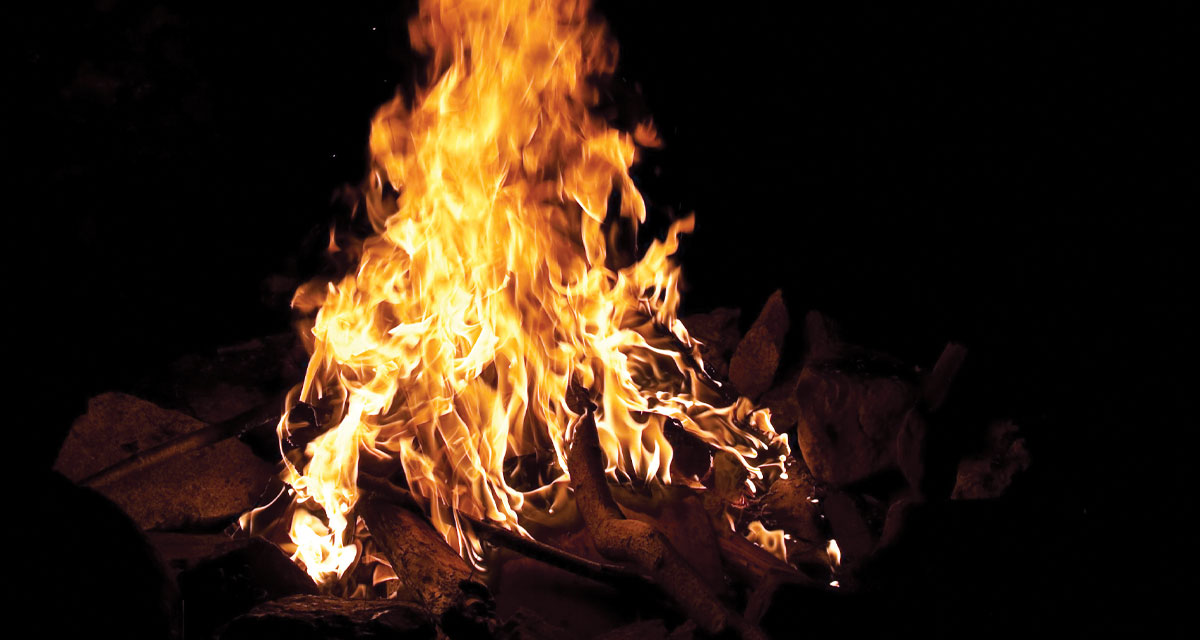The holder of the match has a significant responsibility. More than in the act of striking, the bearer acknowledges the Spirit of Fire, understanding its correlation to respect. Fire is a living being, dancing, jumping, snapping, and hypnotizing its prey. In the modern world, flames arrive with the press of a button or an automated response within the home. It’s only through lighting physical objects, such as a fireplace, candles, or lanterns, that we hold the matchstick and revere its power. In one instant, a chemical reaction, comprising potassium, chlorine, phosphorus, and sulfur, produces a flare of heat and light.
Long before the match and the striker, fire was a power termed “Puha” and offered in prayer to the one who lives beyond the Sun. The physical energy protected by the symbolic circle of stones continues to live on in campfires and ceremonial rites from ancient civilizations to the Native Americans and cowboys. Firekeepers, or flame tenders, assumed chief responsibility for tending the fire 24 hours a day. Whether suffering from storms, snow, or insufferable temperatures, the keeper managed the hungry flames until the dance ended.
The Firekeepers
The words “fire” and “wisdom” in these civilizations are synonymous, interconnected to shine a light on shared human values and needs. It takes commitment to learn to be a beacon, helping people seek their path through difficulty. The stone circle brings people together, feeding the body through dance and easing the mind. Families and friends can start a monthly ritual centered around the Spirit of Fire, remembering connections, trust, and celebrating the presence of everyone seated. The gift passes on to the young, who also learn the responsibility and dangers of fire by assisting the flame tender with jobs as old as time itself.
- Gathering Tinder: The highly flammable materials found outdoors might include dry pine straw, grass, hanging moss, animal feathers, wood shavings, leaves, or cattails near a pond. The more moisture your potential fuel contains, the less likely it is to produce a spark. Preparing in advance is a time-saver; therefore, ask a child to collect their pencil shavings, find an abandoned bird’s nest, or enclose a paper bag with cotton balls saturated in petroleum jelly. Additional materials are dryer lint, potato chips, sawdust, melted wax, and alcohol-based hand sanitizer gel.
- Collect Kindling: Larger than tinder, kindling can be comprised of rolled-up newspaper, large pine cones, thin cardboards, and softwoods, such as thin sticks of pine or shavings. Size should match the diameter of a pencil and easily be snapped with bare hands. All materials must be dry.
- Stacking Wood: Transporting wood from one location to another sounds like a tedious task, especially to a young child. But it’s part of the old ways, aiding the keeper.
Returning to Old Ways—Making Fire
Blessing the earth before the first spade entered the ground, men formerly dug to create an 18-inch deep firepit. The symbolism continued as tiki poles similar to dowel rods were laid across it, forming a cross. Modern times allow gatherings to occur almost anywhere, with the affordability of a portable, wood-burning or propane stainless steel firepit. And, throughout time, these same rules apply:
- Only the Firekeeper works close to the circle.
- Refrain from placing objects too close to the dancing flames. The Fire Spirits may view them as a gift and singe the edges or consume them whole.
- Arms and hands stretching across the fire disturb the flames and show disrespect to the Spirits.
- Only a limited number of people can meander near the circle.
- Cedar and sage are ideal offerings to purify and clear the air or make peace.
Living with Fire
In our modern age, children need to experience the power of lighting a matchstick to witness firsthand its explosive effects. The burned match has a ceremony too, in its placement, especially within a house. Teachable moments arrive as children interact with flames; perhaps also with the rule never to leave a flame unattended or to be careful when combining grease, food, and fire. The signs of an unhealthy fire, such as billowing smoke building quickly in as little as 30 minutes, lead to fast reactions. What to toss? Is it water or flour?























